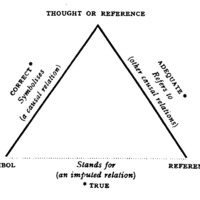-
Title
-
Triangle of Reference (Thoughts, Words and Things)
-
Description
-
This may be simply illustrated by a diagram, in which the three factors involved whenever any statement is made, or understood, are placed at the corners of the triangle, the relations which hold between them being represented by the sides. The point just made can be restated by saying that in this respect the base of the triangle is quite different in composition than either of the other sides. Between a thought and a symbol, causal relations hold. When we speak, the symbolism we employ is caused partly by the reference we are making and partly by social and psychological factors–the purpose for which we are making the reference, the proposed effect of our symbols on other persons, and our own attitude. …Between the Thought and the Reference there is also a relation; more or less direct (as when we think about or attend to a coloured surface we see), or indirect (as when we 'think of' or 'refer to' Napoleon), …Between the symbol and the referent there is no relation other than the indirect one, which consists in its being used by someone to stand for a referent. Symbol and Referent, that is to say, are not connected directly (and when, for grammatical reasons, we imply such a relation, it will merely be imputed, as opposed to a real relation), but only indirectly round the two sides of the triangle.
-
Designer
-
Ogden, C. K. (Charles Kay)
-
Richards, I. A. (Ivor Armstrong)
-
Date
-
1923
-
Source
-
The Meaning of Meaning:
-
Bibliographic Citation
-
Ogden, C. K. and I. A. Richards. 1923 (1946, 8th Edition). The Meaning of Meaning: A Study of the Influence of Language Upon Thought and of the Science of Symbolism. Harcoury, Brace, & World, Inc. Pages 10-12.
-
is depiction of attribute
-
English
Triangle
-
is composed of
-
English
Triangle
-
has attribute
-
English
Dash Line
-
English
Solid Line
-
use feature
-
English
Brace
-
depict things of type
-
English
Conceptual
-
Alternative Title
-
The Semiotic Triangle
-
Coverage
-
communication
-
semiotics
-
sign structure
-
triangle
 ogden-richards.png
ogden-richards.png